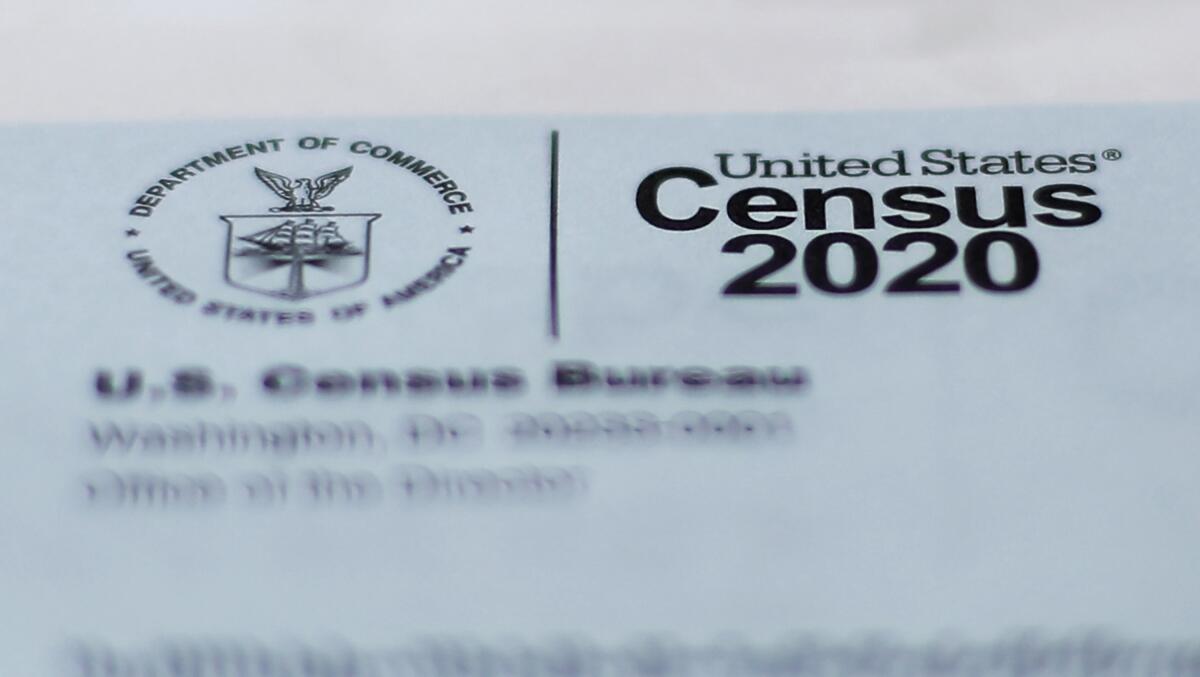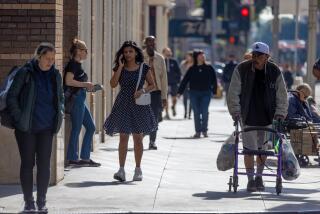California’s hardest-to-count census tract confronts politics, pandemic and fear

The crowd formed a line alongside the taco truck parked near Fremont Park in Stockton and waited for the free fare they’d earned for filling out their census forms.
About 175 residents from San Joaquin County’s Census Tract 1, the hardest to count in the state — most of them Latino or Black — had stopped by on a recent afternoon to “taco ’bout the census” with workers from El Concilio, a nonprofit community organization that partnered with state census and local officials to increase participation among groups that have historically been undercounted.
Flanked by tables filled with information about the decennial count, locals chatted with “trusted messengers” — community members tasked with outreach to hard-to-count groups — and used tablets to complete the survey. Salsa and jazz played in the background as workers gave children census stickers that they proudly displayed on the backs of their hands.
Organizers have had their work cut out for them in a census year that has increasingly become politicized, mired by a pandemic, ongoing court battles, concerns about a potential citizenship question, the safety of respondents’ data and whether information could be used to track or discount immigrants from the survey.
They’ve canvassed neighborhoods and hosted rallies and information sessions where they explained how census data turns into federal dollars that trickle down to states and cities. After the coronavirus wiped out the chance to gather in person, they started phone banks and honed social media campaigns. Now, with the count set to end Oct. 31, they are making their final push before the deadline.
“To get people to open their door, it’s not easy,” said Jose Rodriguez, president of El Concilio, an organization with 52 years of history in the Central Valley that offers education, counseling and job training programs to diverse communities.
He described parts of the census tract as “rough” and a “hot spot for the police” with high crime rates.
“Some people you tell to canvass and they won’t because they are scared, but we will in groups of three,” he said. “We say, they’re our cousins, our friends, our relatives — why wouldn’t we go there? They may have busted street lamps, but they’re people. They still count.”
Despite the organization’s efforts to communicate to locals that a citizenship question is not on the census, it remains “a big issue,” he added, referring to the battle last year over the Trump administration’s argument that the move was necessary in order to better enforce the Voting Rights Act. Opponents countered that it was a transparent ploy aimed at diminishing minorities’ voting power and the federal clout of blue states such as California.
Still, community organizations’ efforts have shown promise in Stockton, where the state’s hardest-to-count tract’s self-response rate is 41.6%, slightly higher than its 36.2% response rate in 2010.
The tract encompasses all the hurdles that other challenging areas in California face, organizers say, but in one place. It’s home to communities of color — more than half the tract identifies as Latino, according to census data — and more than 86% of families primarily speak Spanish at home.
Some 68.8% of its residents have income below 150% of the poverty level, data from the U.S. Census Bureau show.
Most of the housing units in Census Tract 1 (some 98.6%) are renter-occupied, posing another challenge to accurate enumeration. Renters are harder to count because they are more difficult to reach during canvassing and the follow-up with non-responders that requires census workers to knock on people’s doors and urge them to fill out the form. Some may not answer the door for a stranger, and others may not accurately complete the census because they fear a landlord would learn they have more people living in a unit than is allowed.
And in a census that is primarily collecting data online for the first time, between 60% to 80% of households in the tract don’t have broadband internet.
“In many cities and towns in California across the country, there is always one side of town that has the resources that families need to thrive, and on the other side there are families struggling to survive,” said Pablo Rodriguez, executive director of Communities for a New California Education Fund, an organization that has been working to boost participation in the census. “Census Tract 1 is emblematic of that part of town that has been established but is still suffering, especially when it comes to sprawl.”
States draw on census data to form school district boundaries, and many of the services that people rely on in California and across the nation, such as nutrition programs and housing assistance, are tied to funds calculated using the census. In 2015, the most recent year for which an estimate is available, California received about $77 billion in census-related funding — “more than 80% of the total federal funds the state received that year,” according to a report from the Public Policy Institute of California.
In fiscal year 2017, 316 federal spending programs drew on 2010 census-derived data to distribute $1.5 trillion to state and local governments, nonprofits, businesses and households throughout the country, research from the George Washington Institute of Public Policy shows. At stake are not only federal tax dollars but also political redistricting and the reapportionment of seats that each state is allocated in the U.S. House of Representatives.
The tract in Stockton offers a glimpse of the struggles other areas of California with large underserved populations face, including Los Angeles and parts of Orange and Riverside counties, as well as rural pockets with hard-to-track addresses or limited internet access.
This year, Stockton was named the most racially diverse city in the nation by U.S. News and World Report. California is home to seven of the 10 most diverse cities, according to the survey.
With a population around 312,000, the city had been hit hard by foreclosures and bad municipal investments when Wall Street crashed, and it was forced to declare bankruptcy in 2012. Life in Stockton has improved since then, but recovery hasn’t been even across the city, organizers say.
“It’s the tale of two cities that can be seen in Modesto, Bakersfield, Merced and Los Angeles for that matter,” Rodriguez, of Communities for a New California Education Fund, said. “A lack of investment and families that are struggling while other neighborhoods are being overly invested in and are thriving in a very different way. It is definitely a snapshot of something that is happening not just in Stockton but across the state.”
And the shifting census deadlines haven’t helped the cause, he said.
Last month, a federal appeals court decided to let stand a preliminary injunction barring the Trump administration from shutting down the census count early. A three-judge panel of the U.S. 9th Circuit Court of Appeals ruled 2 to 1 that stopping the Census Bureau’s count now “risks undermining” its mission.
For every Californian missed by the census, Los Angeles County officials have said, the state loses about $2,000 a year in federal program funding. The state made a sizable investment in the 2020 count, according to the Public Policy Institute of California, pouring some $187 million into census-related activities since 2018.
So far, 69.4% of California’s households, or more than 10.5 million housing units, have self-responded to the census, compared with 68.2%, or 9.3 million, in 2010.
“That’s historic,” said Ditas Katague, director of the California Complete Count Census 2020 Office. Between 2.15 million and 2.5 million households tallied this year are in hard-to-count areas.
Those who live in difficult-to-track areas aren’t apathetic, Rodriguez said — they’re just cynical and don’t trust that their civic engagement will pay off.
“It’s like, ‘You guys always make promises that you’ll fix the streets, that you’ll improve the parks, but I just don’t see it,’” he said.
Some, he said, feel left behind. When he or others explain that the census is a 10-year investment in the community, they respond that their future is not in that area and that they hope to be gone by the next decade.
“There are people who will say, ‘No matter what it is that I do, there is someone at the federal level putting their thumb on the scales.’ People are nice about it, but there is definitely a sense of hopelessness,” he said. “But in spite of that, California has exceeded its 2010 count overall.”
More to Read
Sign up for Essential California
The most important California stories and recommendations in your inbox every morning.
You may occasionally receive promotional content from the Los Angeles Times.











